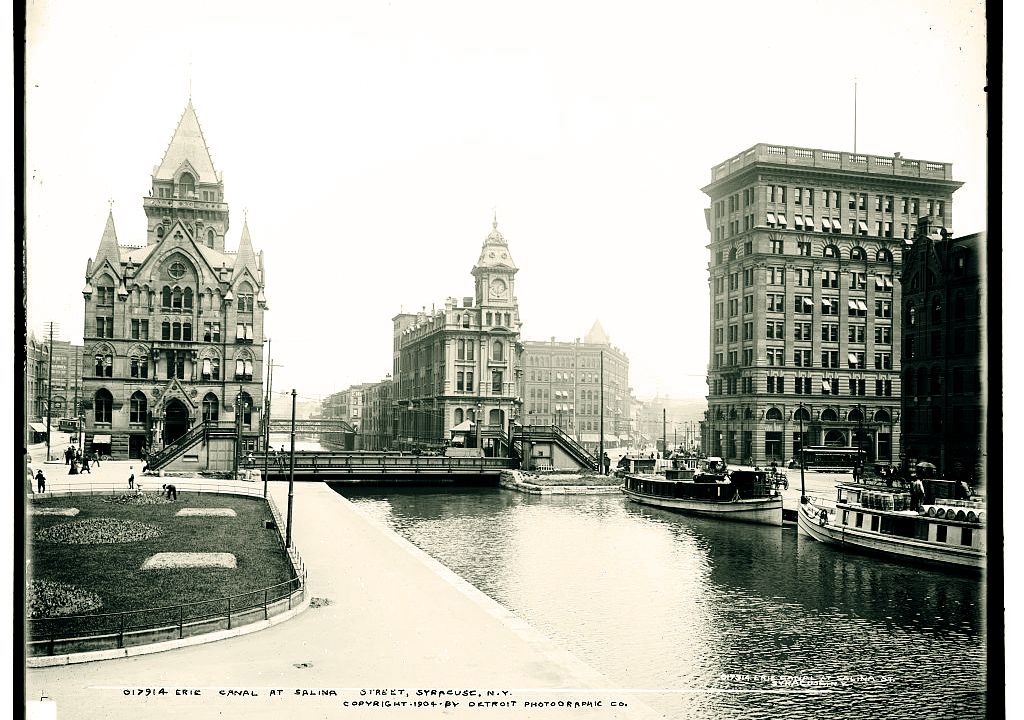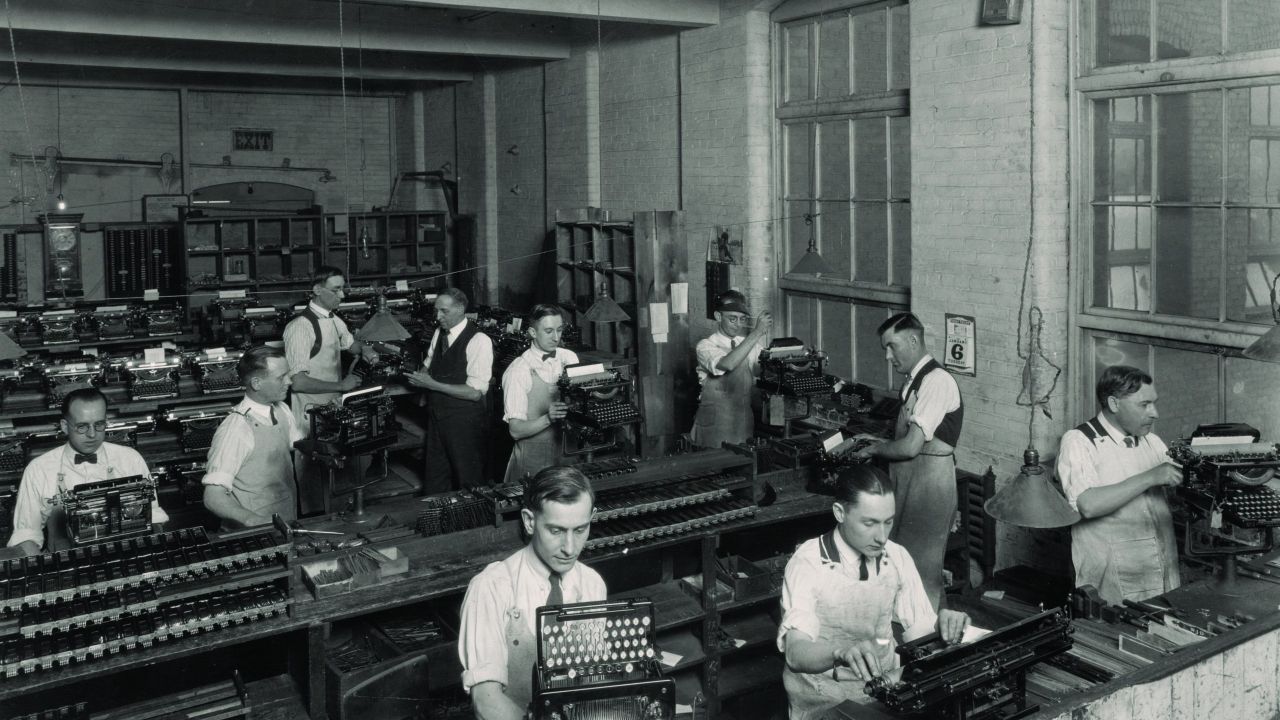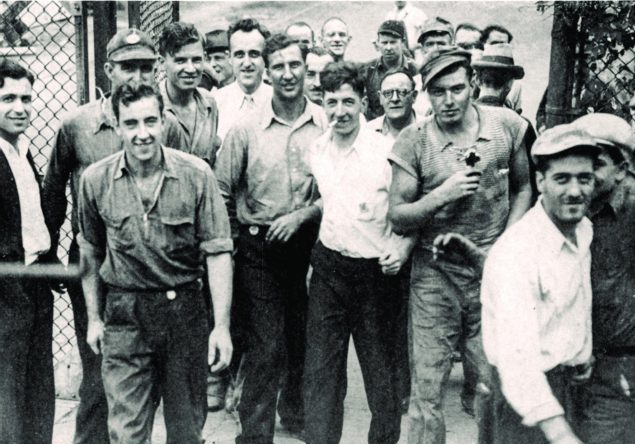
Based on a presentation by Associate Professor Ed Bogucz, Mechanical & Aerospace Engineering, Syracuse University
Written by Renee Levy
When SyracuseCoE headquarters opened in 2010, it became a pioneering building in the city, the region and, perhaps, New York state. One of Syracuse’s first LEED Platinum buildings, SyracuseCoE was built as a showcase of green building technology; a living lab where such technologies are developed and tested; and a hub for technology transfer, connecting student and faculty researchers at Syracuse University, SUNY-ESF, SUNY Oswego and Upstate Medical University with local industry to develop technologies and commercialize innovative products for market.
One hundred years earlier, at the same location—on the corner of East Washington and Almond streets—Lyman C. Smith built the L.C. Smith and Bros. Typewriter Company. Smith was an innovator, local industrialist and benefactor of engineering education at Syracuse University. That symbiosis is no aberration. Syracuse University’s 150-year history is deeply intertwined with innovation and entrepreneurship in the region.
When Syracuse University opened its doors in March 1870, Syracuse was a boomtown and the 29th largest city in the United States. The city’s growth had been fueled by the opening of the Erie Canal in 1825, which along with construction of multiple rail lines, established Syracuse as a thriving hub for advances in civil engineering and canal-to-rail intermodal transportation.
A Cradle of Industry and Innovation
Syracuse’s first known industrial incubator was the C.E. Lipe Machine Shop, established in 1880 by mechanical engineer Charles Lipe. At the 20,000-square-foot Lynch Building on South Geddes Street, Lipe worked on his own inventions and rented space to others, including Herbert Franklin, Alexander Brown and Smith, originally known for the L.C. Smith shotgun. The Lipe Shop became recognized as the “cradle of Syracuse industry” with a prowess for precision manufacturing: the ability to make small parts accurately.
Lipe and Brown invented the Hy-Lo Bi-Gear for bicycles. They later turned their attention to gears and transmissions for the auto industry. Franklin was experimenting with automobile design, and the first Franklin automobile was built at the Lipe Shop. Brown also teamed with Smith on improving the design of the typewriter. Along with Smith’s brothers, Wilbert Smith and Hurlburt W. Smith, they established the Smith Premier Typewriter Works and L.C. Smith and Bros. Typewriter Company, which later became Smith Corona.
In 1901, Lyman Smith donated $75,000 to Syracuse University to build Smith Hall and establish the L.C. Smith College of Applied Science. He later gave $40,000 to build Machinery Hall, all an effort to bolster engineering education.
View the full-color PDF with all historic photos and timeline
By the 1920s, Syracuse’s largest employer was Franklin Automobile, with 5,000 workers. The company’s founder, Herbert Franklin, endowed the Franklin Chair in Transportation at Syracuse University (now known as the Franklin Chair in Supply Chain Management). The company had developed a new type of air-cooled engine that made its product lighter and more responsive than other automobiles at the time, which used conventional water-cooled engines. The air-cooled engine offered a significant reliability advantage in cold climates, given that antifreeze had not yet been invented.
Despite its technological sophistication, discounted pricing and the Great Depression led to Franklin Automobile’s demise, and the company declared bankruptcy in 1934, leaving behind a technologically skilled workforce with no jobs and a large, empty factory.
Local business leaders raised a $250,000 incentive to attract a manufacturing company to Syracuse. Investigating the possibilities, they were successful in recruiting the rapidly growing Carrier Air Conditioning Company. Willis Carrier had invented air conditioning in Buffalo in 1902 to solve the challenge of humidity control in printing plants. When Carrier’s employer ended production of the novel technology in 1914, Carrier started his own company in Newark, New Jersey. In 1922, Onondaga Pottery in Syracuse became the first customer to use Carrier’s new centrifugal chiller.
In 1937, Carrier consolidated its manufacturing from four locations in New Jersey and Pennsylvania to the former Franklin Automobile factory in Syracuse. The company grew quickly.
During World War II, the federal government built a factory in DeWitt, a Syracuse suburb, for General Electric to build jet engines. After the war, the site was auctioned off. There were two bidders: Carrier Corporation—which needed larger manufacturing facilities—and Syracuse University—whose enrollment had tripled with Chancellor William P. Tolley’s strategic decision to open the doors to returning veterans on the G.I. Bill. Ultimately, the site was divided between the two.
In 1947, Carrier moved to the larger manufacturing complex off Thompson Road. (When a traffic circle was built in front of the plant in the 1950s, it was named Carrier Circle.) The L.C. Smith College of Engineering moved from Smith and Machinery halls to buildings adjacent to the Carrier Corporation. Engineering students from that time period recall being bused from the main campus to Thompson Road, where engineering classes were held from 1948 to 1952.
By the late 1970s, Carrier had grown to become the world’s largest air conditioning company, with more than 7,000 employees in Syracuse, in research and development, manufacturing and administration. In 1979, Carrier was acquired by United Technologies Corporation (UTC). By 2004, UTC moved Carrier’s headquarters to its own headquarters near Hartford, Connecticut, ending manufacturing in Syracuse. Approximately 1,300 research and development employees remained, and more importantly, so did much of the engineering brain trust that would become crucial to the creation of SyracuseCoE.
Responding to Industry Needs
But Carrier was far from the only innovation industry in town. Beginning in the 1960s, long before Silicon Valley, Syracuse developed as a hub for electronics and instrumentation, with key firms including Welch Allyn, GE Electronics Park, Anaren, Inficon, Martin Marietta and Thomson Consumer Electronics. At the same time, there were parallel developments at Syracuse University in the creation of related academic programs to meet the needs of emerging industries. For example, Syracuse University has the second oldest computer engineering program in the country, due to a longstanding relationship with IBM. Other innovative programs included a bachelor’s degree in environmental engineering, a minor in energy systems and a master’s degree in energy systems.
Central New York was also home to a cluster of successful engineering firms, most prominently O’Brien and Gere, founded by William Stanton Gere, a 1917 graduate of Syracuse University and son of one of Syracuse University’s first known civil engineering graduates, William Anson Gere, who earned his degree in 1884.
Ed Bogucz, founding director of SyracuseCoE, came to the L.C. Smith College of Engineering as a young faculty member in 1985, attracted by the University’s proximity to Carrier Corporation and the possibility of research collaboration through SU’s newly established Center of Advanced Technology in Computer Applications and Software Engineering (CASE) Center. It was a good move. His first sponsored research project was a project for Carrier funded through the CASE Center.
In the early 1990s, Syracuse University Chancellor Kenneth Shaw led a process to reduce the University’s budget and better respond to market demands. As part of the restructuring effort, the University combined the L.C. Smith College of Engineering and the School of Computer and Information Science to create the College of Engineering and Computer Science (ECS). In 1995, Bogucz was named ECS’s interim dean, charged with developing a strategic plan for the college as it completed its downsizing.
Bogucz’s vision was to strengthen ECS by hiring faculty members in areas that aligned with strengths in the local economy and to strengthen collaborations with local firms. At the same time, the Metropolitan Development Association (MDA) was developing Vision 2010, a blueprint to strengthen the CNY economy. The regional blueprint identified seven key CNY industry clusters, including environmental quality and energy systems. In 1996, the College of Engineering and Computer Science adopted a strategic plan that included investments in faculty and facilities aligned with Vision 2010 priorities. In July 1996, Bogucz was named ECS’s dean, charged with implementing the plan.
To advance Vision 2010, the MDA organized working groups for each industry cluster. The working group for environmental and energy systems was co-chaired by Cornelius B. Murphy G’70, chief executive officer of O’Brien & Gere. In 1998, the group invited Bogucz to facilitate a brainstorming of possible areas for collaboration among Central New York companies. What emerged was a plan to develop new technologies for green buildings, an idea being developed by the fledgling U.S. Green Building Council and supported strongly by Carrier.
Planting Seeds for SyracuseCoE
From there, things moved quickly. In 1999, the College of Engineering and Computer Science recruited Jensen Zhang, the first faculty member hired to build capacity in areas related to indoor environmental quality. The following year, the MDA, now known as CenterState CEO, launched the New York Indoor Environmental Quality (NYIEQ) Center to promote regional university-industry collaborations. In 2001, Bogucz led efforts on a successful proposal to the state to establish the Environmental Quality Systems (EQS) Strategically Targeted Academic Research (STAR) Center, led by Syracuse University in collaboration with the NYIEQ Center, MDA and 10 academic and research institutions. H. Ezzat Khalifa, director of Carrier R&D programs at United Technologies Research Center, was hired to lead the EQS STAR Center.
Later that year, New York State announced a new Centers of Excellence program to foster collaboration between the academic research community and the business sector to develop and commercialize new products and technologies. In 2002, SyracuseCoE was established by New York State as one of the first five statewide Centers of Excellence, leveraging activities of the NYIEQ and EQS STAR centers, with a mission to encourage and fund collaborative projects that develop new environmental and energy systems products and services, serving as a conduit between university researchers and industry.
Since its creation, SyracuseCoE has supported more than 200 projects that assisted more than 70 local companies, which report creating or retaining more than 1,100 jobs to date. In addition, SyracuseCoE has supported more than 50 Syracuse University faculty members in seven schools and colleges through its Faculty Fellows Program, which provides competitively awarded funding for seed projects.
In 2009, SyracuseCoE hosted the ninth International Society of Indoor Air Quality and Climate Healthy Buildings conference and exhibition, which attracted more than 1,700 attendees from 44 nations. The following year, SyracuseCoE opened its LEED-Platinum living laboratory headquarters in downtown Syracuse, on the brownfield that was the site of the L.C. Smith and Bros. typewriter factory. A thriving hub for industry-University collaboration and an anchor to Syracuse’s Innovation Crossroads, SyracuseCoE’s unique facilities have attracted international research teams, including the groundbreaking COGfx Study on the impact of indoor environmental quality on human cognition led by the Harvard T.H. Chan School of Public Health in 2014.
Last year, leading researchers from 33 countries gathered in Syracuse for the seventh International Building Physics Conference, hosted by SyracuseCoE and chaired by Zhang, Syracuse University professor of mechanical and aerospace engineering. It was the first time that the triennial meeting, the world’s premier building science conference, was held in the United States, attracted to Syracuse by the cutting-edge research and innovation related to indoor air quality, energy efficiency and high-performance building technologies.
Syracuse University and the Central New York community are undisputed leaders in the field, all because Syracuse University had the foresight to build programs, hire faculty and invest in facilities in areas relevant to local industry. The result: significant impact on our regional economy, our built environment and natural environments and our water resources.







